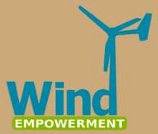| The VIRYA-3, the VIRYA-3B3, the VIRYA-4.2 and the VIRYA-4.6B2 windmills. These four VIRYA windmills are designed especially for manufacturing in developing countries.The VIRYA-3,the VIRYA-4.2 and the VIRYA-4.6B2 have 2-bladed rotors. 2-bladed rotors are easier to manufacture and to balance and can even be transported completely mounted. The VIRYA-3B3 has a 3-bladed rotor and the rotor and head looks very much the same as the old VIRYA-3.3 (see photo). The Pel-V curve of the VIRYA-3B3 is the same as thatof the VIRYA-3. The rotor blades are made of hard wood and have a constant chord and notwist.The rotor geometry, the rotor characteristics and the Pel-V curve have been calculated in report KD241 for the VIRYA-3, in KD 484 for the VIRYA-3B3, inKD218 for the VIRYA-4.2 and in KD584for the VIRYA-4.6B2. The generator of the VIRYA-3 is mechanically the same as the generator oftheVIRYA-2.68but has a modified winding. The generator of the VIRYA-4.2 is almost identical to the generator of the former VIRYA-3.6 but the shaft diameter has been enlarged from 30 mm to 35 mm. The generator of the VIRYA-4.6B2is almost identical to the generator of the former VIRYA-5A but the shaft length is shorter. The generators of the VIRYA-3,the VIRYA-3B3 and the VIRYA-4.2 have been measured (see report KD 78 and KD200). The generator of the VIRYA-4.6B2has not yet been measured but measurements of the former VIRYA-5A generator (see report KD 82) were used to determine the Pel-V curve. All windmills have generators based on standard rotary current motors. This motor is modified with a permanent magnet armature with neodymium magnets and a stainless steel shaft. The windmill rotor is mounted directly to the tapered shaft of the generator and the rpm range is much lower than the nominal motor rpm. The VIRYA-3 and the VIRYA-3B3 make use ofa modified 115/200 V winding in star for 24 V battery charging. For the VIRYA-4.2, the standard 230/400V winding in star can be usedfor 48V battery charging. The VIRYA-4.6B2 makes use of thestandard 400/690 V winding in star for 96V battery charging and a modified 200/345 V winding in star for 48 V battery charging. The generator can be used as a brake by short-circuiting the winding. The batteries are protected against over charging by one 27.6V battery charge controller for the VIRYA-3and the VIRYA-3B3. The VIRYA-4.2 and VIRYA-4.6B2have two 27.6 V battery charge controllers and two dump loads in series and can there fore be used for both 24 V and 48 V electrical equipment. A prototype of the VIRYA-4.2 is tested by Kragten Design from 2004 up to 2006. Drawings and manuals of the VIRYA-3, the VIRYA-3B3and the VIRYA-4.6B2are ready but prototypes will not be tested by Kragten Design.The mills are provided with a “hinged side vane safety system” to limit rotor rpm and thrust at high wind speeds. The rotor axis is offset from the tower axis. The vane juts out along the rotor and the vane bladeis connected to the vane arm using hinges. At low wind speeds the vane blade hangs in almost vertical position and the rotor is perpendicular to the wind. At wind speeds higher than about 6 m/s the rotor starts to turn gradually out of the wind. At very high wind speeds the rotor turns out of the wind by about 75° and the vane blade is in almost horizontal position. The behaviour of this system is very stable and the rotor speed is well controlled. A description of this safety system with all formulas for calculation of the -V curve for the VIRYA-4.2 is available (report KD 213).The tower of the VIRYA-3 + the VIRYA-3B3 is identical to the tower of the VIRYA-3.3D and the VIRYA-3.8. This tower has a 3 m upper part made of pipe and two 3.5 m parts made of angle iron. Both the VIRYA-4.2 and the VIRYA-4.6 make use of the same tower which is almost identical to the tower of the formerVIRYA-3.3 which has been tested for 12 years. The VIRYA-4.2 and VIRYA-4.6B2have a 12m, three legs lattice tower made of pipe and horizontal strips. The tower consists of two 6m sections which are bolted together (the former VIRYA-3.3 tower has only one 12 m section but the geometry is the same). The lowest section of both towers is connected to the foundation by hinges. The head bearings are waterproof and the mills are almost maintenance free. A prerequisite for manufacture of these VIRYA windmills is that a well equipped workshop is available and that one should be able to import some of the materials and standard parts. Kragten Design cannot supply materials and parts such as bearings, generator housings, permanent magnets, electronics et cetera. The required workshop skills are sawing, drilling, turning, milling and welding.
|
|
Data
|
| Size |
229.09 KB |
| Author |
Dit e-mailadres wordt beveiligd tegen spambots. JavaScript dient ingeschakeld te zijn om het te bekijken. |
| Website |
Website  |
|
Download
|
|



 Renewable energy world
Renewable energy world
 Watt is duurzaam
Watt is duurzaam






